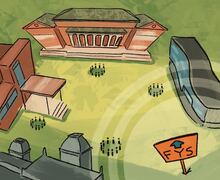Art and technology come together at the SALT Makerspace
Lukas Halloran | Staff Photographer
The SALT Makerspace's offers two 3D printers, computers with software that works with the printers and a laser cutter.
There’s a space in downtown Syracuse where just about anything can be made.
A student produced jewelry modeled after a ring she made out of an old key for an SU jewelry class; a man designed a golf-ball washing device; an artist used a laser etcher to create woodblock prints.
The Syracuse Arts, Learning & Technology (SALT) Makerspace is for artists, engineers and hobbyists who want to bring their ideas to life using advanced technology. The space offers two 3D printers, computers with software that works with the printers and a laser cutter that can be used for etching and creating prints. They also offer classes in using the 3D printers, 3D modeling software, laser cutting and Adobe Illustrator.
Membership to SALT Makerspace is available, as well. For $60, members have access to the space’s services from 2-10 p.m. Tuesdays through Fridays, and for $100, members have 24-hour access — this option will be open to only 10 members to start, though.
The SALT Makerspace moved to its new location on Oct. 1. Formerly located at the Delavan Center in downtown Syracuse, with a 1600 square foot woodshop and metal shop and a 700 square foot clean space, to the second floor of 201 W. Jefferson St. in a 400 square foot office inside Coworks.
The move of SALT Makerspace came down to lack of funding and space. In order to cut costs, the new location will no longer have a space for the woodshop and metal shop.

Lukas Halloran | Staff Photographer
The idea for SALT Makerspace sparked after its director Michael Giannattasio graduated Syracuse University in 2012. Giannattasio, who has a M.F.A. in sculpture from SU, was trying to figure out his post-college plans and his friend and future business partner, suggested he check out the idea of making a shared community space for creating. Her son worked at one in Somerville, Massachusetts, called Artisan’s Asylum. The SALT Makerspace officially opened in Sept. 2014.
Giannattasio said that one of the most rewarding parts of the Makerspace is the result of collaborations between its diverse users — they’ve included SU students, Le Moyne College students, retirees and small business employees.
“When you get the tech person who has that very analytical mind and you get the artist with the very analytical mind, they’re each bringing a really different angle to a similar situation,” Giannattasio said. “Usually what results from that is some really nice stuff.”
One example of technology and arts intertwining at the Makerspace began when a man who worked an office job at SRC Inc., a research and development company, started coming to do his work at the Makerspace just to socialize.
“He was like, ‘I want to be somewhere I can have a conversation, take a minute and bullsh*t with somebody,’ so he would come in and do his work sitting at the tables because other people were around doing stuff and he could stop and have a conversation,” Giannattasio said.
Eventually, the man began a project at Makerspace. The computer architect started talking to a member who was a graphic designer about creating a different kind of tablet interface, and the two began working together. Giannattasio said that these interactions are characteristic of the SALT Makerspace.
Giannattasio said he is looking forward to the new location. Now that it’s on the Connective Corridor, SALT Makerspace will be more accessible. In Armory Square, it also will be in one of Syracuse’s greatest hubs of local businesses. He plans on introducing workshops at the new location, such as a Make Your Own Action Figure lesson.
Annalena Davis, who uses the SALT Makerspace to create matte and woodblock prints, is looking forward to the new location but said that she’ll miss the artistic community of the original spot.
“It’ll be a different space. I don’t know if it’ll be as art-centered. I think it’ll be a new exposure both to people in the Cowork space and the Makerspace and how they can work together,” Davis said.
However, the plan is for the new location to be temporary. Giannattasio said to reach its maximum potential, SALT Makerspace is going to need to relocate and reopen its woodshop and metal shop. Giannattasio said that they’re going to need a 3,000 or 4,000 square foot space — which would require $2,500 a month — to reopen the woodshop and metal shop.
To achieve this goal, Giannattasio plans on meeting with local businesses to redefine his business plan, going to national grid for advertising grants, applying for grants from local foundations and organizations, involving local Syracuse schools, starting a Kickstarter page and relying on donations.
“All these organizations really need to get involved because for the most part they’ve said, ‘We love this idea, we love what this is,’ and they need to show that love and show that monetarily for us to continue to exist,” Giannattasio said.
Giannattasio said for SALT Makerspace to be successful, it will need the support of the entire community, including Syracuse’s universities, local businesses and the CenterState Corporation for Economic Opportunity.
“I truly believe that with the Makerspace and the relationships that we’ve built, anybody can make anything in this space, and they can make anything in Syracuse,” Giannattasio said. “The sky’s the limit.”
Published on October 4, 2015 at 9:27 pm
Contact Alex: aerdekia@syr.edu





